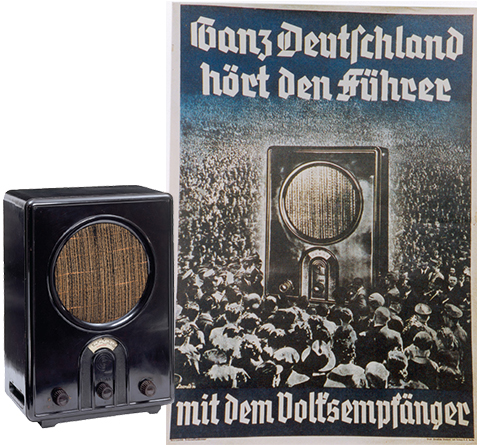Living in the Past: Nazi Propaganda and Consumer Goods

It is easy to forget that the Volkswagens that zip around America’s streets today got their start in Hitler’s Germany, introduced as part of a Nazi campaign to provide inexpensive but attractive consumer goods to the Volk (people). Marketed to Aryans, but not to Jews and other “racial enemies,” the Volkswagen (or People’s Car) and other People’s Products, including the People’s Radio, the People’s Refrigerator, and even the People’s Single-Family Home, symbolized a return to German prosperity. As the advertisements shown here suggest, the appeal of material abundance was a central plank in Nazi propaganda.
Despite Hitler’s promise of a “new, happier age” that would “make the German people rich,”* many of these consumer goods remained out of reach of ordinary Germans. The Volkswagen was a case in point. The car was sold by subscription, and a purchaser made weekly deposits into a savings account. When the balance was paid off, the customer would receive a car. By the end of the Nazi regime, some 340,000 Germans had opened such savings accounts. Yet because of problems with production, the car’s relatively high price, and the concentration on armaments production in the late 1930s, not one People’s Car was delivered to a private customer.

In contrast, the People’s Radio was a unique success. The modest VE-301 radio was much cheaper than standard models, and between 1934 and 1942 the number of Germans who owned radios doubled. Many people could now sit at home and listen to broadcasts ranging from popular and classical music to speeches from regime leaders like Minister of Propaganda Joseph Goebbels, whose tirades were so inescapable that Germans nicknamed the VE-301 (shown above) the “Goebbels snout.”
* Peter Fritzsche, Life and Death in the Third Reich (Cambridge, Mass.: Harvard University Press, 2008), p. 59.
QUESTIONS FOR ANALYSIS
Question
bIkvfKFoWK4E6Cnot/y4DRASpkT6L2EBQEzjaQ8c6mVRvIOJIrVqOEwGIsbmAkc0GPqlPQeGNpuP/fmjzp2P7ZdNj7nayvHSvlBRhBVPS6LbTW65mQ93Ao0PwGpZMUEtiVdSCuYmlt0+b1NxidoFzQX/r/8v7oJsdtyO2Z74sErc3pALh04FQOBU6rj3a2W4F4elaRFk6lyA/1YWg9aidHkyNBJRzgjevynCRi2S9AI=Question
40NkgewhWHfOJz91Rq2hZP6oGSE3j3WwwKVzeLHciKeq03nA5UR6TjebwBieFJ78GMEDrzN6Py6tHt2mLrFVuwpdHGOujdvQmpNc8WZsXJmjZ3i52br3OvVXogcegkfT9p+fQBExMvq7rV9svXhgmYeBd4Qvp8rZKLbF5NGNMfq8hKMrT8m2SkDS6Xq7RJD0I/95fSi7jq+2KQQySKAD+Ju0pe+uFmzFwNHGMYNIdQtsa4kcRa+Pp6c8jfPI9dmYS5t4hJbQaOekvlgfGsj5Xllf6+OnkdZgY5b2AjLEa3DJHt4/eSKSJ1IJANTk2gvWpw/rNuqhUzY5z1dJQuestion
qZziIu3hwJVSTZR09NpLaVsIgTlx5LlMRT78oA32hOeVwhYJth4qjHUO/OtBoVuHS/d+XqhsWkZWBd2q383rPchq3F/Ie63xuXhS7iCIY8NrCN9ve6+250IE0cw3QsA0